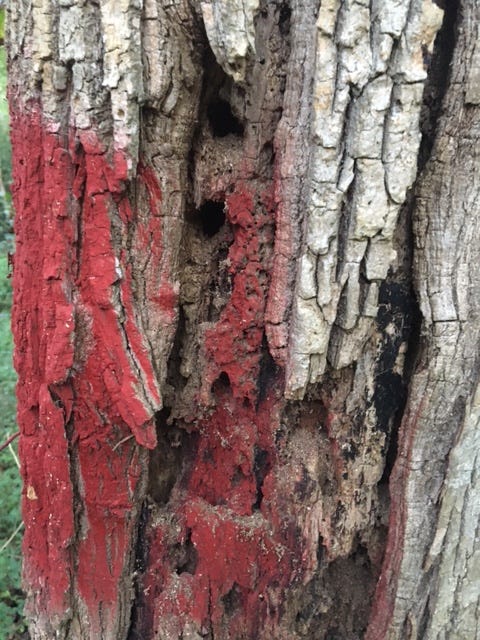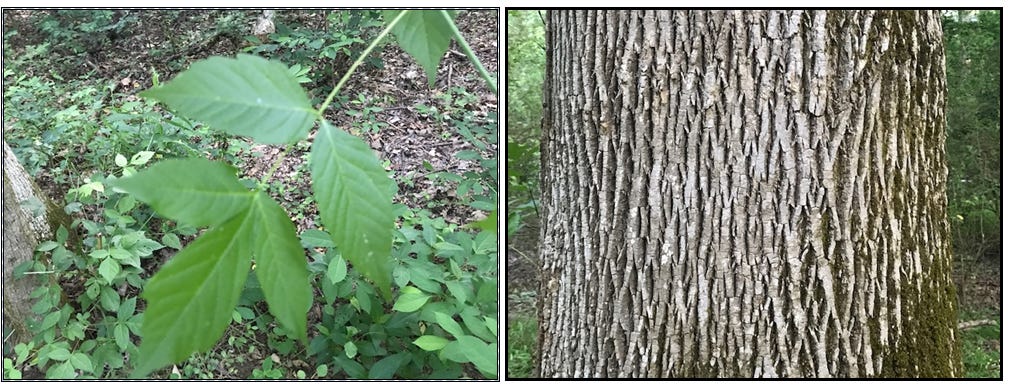Bark-devouring beetles are killing greenway ash trees
Plus: High school graduations; BofA juggles return to office with flexible schedules; May's rezoning petitions; CMS to auction clear backpacks; Heat wave this week
Good morning! Today is Monday, June 13, 2022. You’re reading The Charlotte Ledger, an e-newsletter with local business-y news and insights for Charlotte, N.C.
Need to subscribe — or upgrade your Ledger e-newsletter subscription? Details here.
Today's Charlotte Ledger is sponsored by Fox Rothschild, a national law firm whose Charlotte-based attorneys provide litigation, real estate, labor and employment, corporate and a wide range of other services to clients in the Carolinas and across the country.
Mecklenburg parks officials fight losing battle against half-inch-long emerald ash borer; ‘massive die-off’ at McAlpine Creek Greenway
Dead ash trees stand along the McAlpine Creek Greenway in southeast Charlotte, victims of an invasive beetle called the emerald ash borer. Green ash trees have a signature crisscross bark. (Photos by Amber Veverka)
by Amber Veverka
The start of summer beckons in the region’s extensive greenways, but Mecklenburg County’s publicly owned green spaces are under attack from a half-inch-long insect that’s turning whole areas of our urban forest into tree graveyards.
The emerald ash borer, an invasive pest that has devastated vast tracts of ash trees across North America, was first identified in Mecklenburg some six years ago.
Since then, it has killed native ash species so rapidly that Mecklenburg County Park and Recreation staff are scrambling to deal with the damage. Ash trees love floodplains — where most county greenways run. In certain stretches where ash is nearly the only species present, greenway users soon may see more dead trees than living.
‘Forest of the dead’: Christa Rogers remembers the call she got in 2016 from a contact at Catawba Lands Conservancy. The conservancy had found an emerald ash borer on one of its Gaston County trails. “It wasn’t even on our radar at the time,” said Rogers, a North Carolina registered forester and natural resources manager with Mecklenburg County Park and Recreation. Rogers went out to investigate county property.
“I started looking along the north branch of Torrence Creek Greenway, which had been recently constructed, and saw a lot of dead ash,” Rogers said. High up on the trunks was the telltale sign: D-shaped exit wounds where the adult beetles had emerged. “Then I knew we had them,” she recalled. “I found an actual bug lying dead on the Torrence Creek Greenway.”
The beetle came from Asia in solid wood packing material as early as the 1990s, according to scientists in Michigan, where the beetle first arrived and where it has killed some 40 million trees. Adults lay eggs in ash tree bark and larvae tunnel squiggly trails as they devour the inner bark, cutting off the tree’s circulation of food and water. The insects emerge from the tree as shiny, metallic-green adults. They can only travel five or fewer miles to find new trees — but have spread rapidly across the continent, helped in part by people moving firewood. In Mecklenburg, green ash is the variety most affected by the borer.
![[resize output image] [resize output image]](https://substackcdn.com/image/fetch/$s_!PApR!,w_1456,c_limit,f_auto,q_auto:good,fl_lossy/https%3A%2F%2Fbucketeer-e05bbc84-baa3-437e-9518-adb32be77984.s3.amazonaws.com%2Fpublic%2Fimages%2Fecab72fa-a152-479b-8e26-d85cd6645353_300x534.gif)
Ash trees are dying in parks and nature preserves, as well. But the toll is most stark in the greenways, consistently county residents’ most-requested amenity.
Marked for removal: On a walk through the McAlpine Creek Greenway in southeast Charlotte, the first thing greenway users may notice is bark peeling away from trees. A glance skyward reveals skeletal canopies. Now, dozens of tree trunks are marked with red paint for removal.
To be sure, greenways are home to other tree species — sycamore are fond of wet conditions, sweet gum are the survivalist opossums of county woodlands, and stately cottonwood and tulip poplar can grow to massive size. White, red and willow oaks will hug drier spots. But ash is the king of many local floodplains.
Huntersville ‘moonscape’: Along Torrence Creek Greenway in Huntersville, parts of which now look like “a moonscape,” as one observer put it, dead ash dominate the landscape, causing some walkers to call the Park and Recreation to complain. The county leaves dead trees to fall naturally, unless they’re close to a trail or otherwise imperil life or property. These days, that’s a lot of trees, said Mike Monroe, county greenway operations manager.
“The worst hit is Torrence Creek Greenway. Then McAlpine — we started realizing there’s a massive die-off in there,” he said. “We had some at Central Avenue and Masonic Drive on floodplain property the county bought.”
The county is developing a new greenway off W.T. Harris and I-485, near a Target store. Unfortunately, the new boardwalk curls around a pocket of woods composed almost entirely of ash. “I call it the forest of the dead,” Monroe said in a recent interview. “I was up there this afternoon taking pictures of this brand-new handrail that’s been damaged by falling trees.”
A tree-cutting crew slogged through the wetland near the new greenway on a recent morning, felling trees overhanging the yet-to-open walkway. The nearby sounds of traffic were drowned out by the roar of the chainsaw as it bit through bark. Each dead tree shuddered and uttered an ominous crack before crashing into the water.
Changing the ‘greenway experience’: It’s possible to save a healthy ash tree — emphasis on “a.” Systemic treatments for emerald ash borer can cost hundreds or more for a single tree over its lifetime, making prevention impractical for an entire forest. The county has treated select trees, such as specimens in Charlotte’s Freedom Park, and some homeowners choose to do the same with a beloved backyard tree. But in the greenways and other public spaces, nature takes its course.
“These are large native trees used by wildlife as cavity trees,” Rogers said. “It’s a sad thing. It’s one of so many threats to our forest.”
Workers paint red markings on ash trees that need to be removed because of emerald ash borer infestation. This tree on the McAlpine Creek Greenway has the telltale signs: peeling bark and exit holes where the beetles emerged.
Josh Blackburn, county arborist and operations specialist, spends much of his time organizing and directing ash tree removal. Park and Recreation uses its own crews where it can and contracts with local tree companies for another portion, and the work may soon strain the existing budget. Blackburn, who has been working with trees since he was 14, grew up in Charlotte and remembers when some roads were once dirt, and some shopping centers once forest. Any tree death pains him.
“During the course of its life, the average oak tree gives back about $5,000” in shade, cooling, stormwater capture, carbon offsets and more, Blackburn said. Removing borer-killed ash trees — such as those dangerously close to the new W.T. Harris-I-485 greenway — costs thousands. But the impact of the emerald ash borer is about far more than money, forestry experts said.
“It’s just a great loss to lose the tree canopy,” Monroe said. “We don’t need that, that’s for sure. I hope a native pioneer species comes in and can re-establish itself, because it would be a shame to lose that much tree canopy along the greenway. It changes the greenway experience.”
Ashes to ashes — What you can do:
Don’t move firewood. Emerald ash borer and other pests exit moved wood to infest new areas.
When you’re on public property, if you see a dead tree close to the trail, call 311 and ask to be connected to the Park and Recreation staff. If you don’t know if the land is overseen by the city or county, someone at either location should be able to tell if you if you give the location.
Want to save an ash on your property? Josh Blackburn of Mecklenburg County suggests contacting a certified arborist for an evaluation — many are free — to learn your options for treatment. Trees already infected with borers likely can’t be saved, but healthy ones have a good chance with the use of a systemic insecticide, and for a big tree, it can be cheaper than having it taken down. There are DIY options, too.
Wondering what an ash tree even looks like? Here are photos of a green ash’s leaves and its signature crisscross bark:
Amber Veverka is a freelance writer and editor. She can be reached through her website, amberveverka.com.
Today’s supporting sponsors T.R. Lawing Realty…
… and Whitehead Manor Conference Center, a peaceful, private, and stress-free space for your organization’s next off-site meeting or event. Conveniently located in South Charlotte, Whitehead Manor is locally owned and operated and provides modern meeting capabilities with attention to stellar service!
Big weekend for CMS graduations
A NEW CHAPTER AWAITS: Seven Charlotte-Mecklenburg Schools high schools celebrated graduations on Saturday, with another 18 scheduled for Monday, Wednesday and Thursday. Clockwise from top left: Julius Chambers High School, Butler High School, West Charlotte High School. (Source: CMS)
BofA balancing act: Back to the office – but with flexibility
Technically, most companies uptown are back in the office. But that doesn’t mean that everybody is back in the office full-time.
The business publication Insider took an in-depth look last week at how the post-Covid return to the office is playing out at Bank of America, which is one of Charlotte’s largest employers, with about 16,000 in the region.
BofA CEO Brian Moynihan has been outspoken about the importance of having people in the office. But attendance at work has been spotty and varies by division, Insider said (article available only to its subscribers):
BofA first called back vaccinated employees to the office in March, and the results in the months since have been a mixed bag — leading to some frustrations, employees said.
Some employees told Insider in interviews over the past several weeks that they had witnessed lackluster attendance in their divisions, while others said they’d observed people coming in five days a week. Officially, the company’s policy is to encourage employees to work from the office — but not to prohibit those who need it from enjoying occasional flexibility to work from home.
Some divisions are back five days a week, while others are back three, the publication said. Managers also have access to card-swipe data, which is raising some concerns about how much the bank is monitoring employees’ attendance at the office. Fridays seem especially empty, Insider said, mirroring what we’ve heard here in Charlotte.
It sounds like a delicate balancing act, weighing the needs to give flexibility to employees in a tight job market while meeting the goal of returning people to work. People who work uptown tell us it doesn’t feel fully back to normal, which would make sense if thousands of people are there only a few days a week. The big question is whether hybrid work arrangements will be long-lasting or just temporary vestiges of Covid-era work-life balance.
Asked about BofA workers’ return to the office in Charlotte, a spokeswoman told The Ledger:
Bank of America has always had flexibility within our work culture, even since before the pandemic. Our return to office plans haven’t changed and as previously shared, we’ve continued to bring back all U.S. workers, both vaccinated and unvaccinated, back into the office by June 1.
Additionally, employees continue to have some flexibility to work from home, but they are strongly encouraged to collaborate with colleagues in person.
—TM
May rezonings 🔥: Apartments aplenty for Mallard Creek
It’s everyone’s favorite time … rezoning time!
Each month, The Ledger rounds up rezoning filings with the city for the previous month. It’s a window into developers’ plans for apartments, townhouses, warehouses and more. Much more.
Last month, developers disclosed to the city their plans for:
Apartment towers in SouthPark, Midtown and Plaza-Midwood
Apartment developments in the Mallard Creek area, totaling more than 1,400 units
Townhomes in Myers Park
Duplexes off Sugar Creek
The information we compile is available only to our community of paying members (🔒). Enjoy!
In brief:
CMS to auction clear backpacks: Charlotte-Mecklenburg Schools plans to auction off the 46,000 clear backpacks the district ordered to help improve student safety. The backpacks cost more than $440,000 but were never distributed after officials discovered they had warning tags about cancer-causing chemicals. (WSOC)
Transgender healthcare: A federal judge ruled that North Carolina’s health plan for state employees illegally discriminates by failing to offer certain procedures to transgender workers and their dependents. The judge ordered that the plan offer “medically necessary services for the treatment of gender dysphoria.” State Treasurer Dale Folwell, whose department administers the health plan, said that his office was reviewing Friday’s decision and that the state has traditionally had the ability to run the program. (Spectrum News/AP)
Who wants to run for school board? Charlotte-Mecklenburg Schools is holding an information session for people interested in running for school board this year. “Join us for an introduction to the roles and responsibilities of the CMS Board of Education.” It’s June 30 at 3 p.m. (CMS on Twitter)
Top city salaries: City Manager Marcus Jones has the highest salary of any city employee, at $379,587. He’s followed by CATS CEO John Lewis ($282,177), City Attorney Patrick Baker ($269,462), Assistant City Manager Brent Cagle ($266,792), airport director Haley Gentry ($262,500) and Assistant City Manager Tracy Dodson ($262,302), according to a database obtained by our good friends at the Charlotte Business Journal (subscriber-only).
Hornets agreement, streetcar on agenda: At a meeting tonight, the City Council is expected to discuss and vote on plans to renovate the Spectrum Center and chip in for a Charlotte Hornets practice facility ($215M in tourism tax money, plus $60M expected to come from the sale of naming rights) and to fund initial planning for the expansion of the Gold Line streetcar ($4.3M).
Tillis, Burr support gun-violence agreement: North Carolina’s Republican U.S. senators, Thom Tillis and Richard Burr, say they back the gun violence legislation compromise announced Sunday that would boost mental health and school safety programs. (Observer)
Hot enough for ya? A heat wave bringing highs in the upper 90s and possibly to 100 degrees is expected to arrive today and last through Friday before temperatures drop to a still-too-hot high of 90 on Saturday. (WBTV)
Taking stock
Unless you are a day trader, checking your stocks daily is unhealthy. So how about weekly? How local stocks of note fared last week (through Friday’s close), and year to date:
Need to sign up for this e-newsletter? We offer a free version, as well as paid memberships for full access to all 4 of our local newsletters:
➡️ Learn more about The Charlotte Ledger
The Charlotte Ledger is a locally owned media company that delivers smart and essential news through e-newsletters and on a website. We strive for fairness and accuracy and will correct all known errors. The content reflects the independent editorial judgment of The Charlotte Ledger. Any advertising, paid marketing, or sponsored content will be clearly labeled.
Like what we are doing? Feel free to forward this along and to tell a friend.
Executive editor: Tony Mecia; Managing editor: Cristina Bolling; Contributing editor: Tim Whitmire, CXN Advisory; Contributing photographer/videographer: Kevin Young, The 5 and 2 Project











